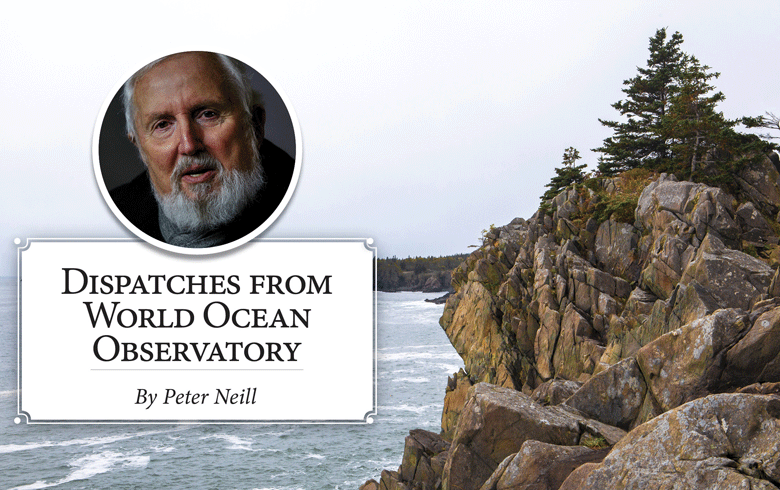Several years ago, I visited Ireland with my son, a musician, and one day we ventured to a small coastal village in search of the grave of a famous Irish traditional singer whose voice and repertoire had shaped my son’s first music in a fundamental way. At the local pub, we learned there were five graveyards in the area and we visited them all in our search to pay homage, a lovely walk along shore looking out over the sea that seemed as much of the place as was the land itself.
We found the stone and, while my son placed a guitar pick in the ground as a respectful tribute, I observed the other stones there, canted by wind and encrusted by the salt air, almost all of which were the final resting place for fishermen, each marked with name, date, and the phrase “lost at sea.”
There are the unmarked graves of men swept overboard or died and committed to the ocean as their final port of call.
Ironically, all the stones were facing inland, as if the mourners had insisted this final resting place must turn its back on what took those lives, and so many others, from a community that fished more than it farmed, and by so doing, lost generations of husbands, sons, and brothers to a cold, hard, dangerous, and unforgiving ocean.
Work on or by the sea is challenged by extremes of weather, wave, wind, and dynamic forces that can equal the wrath of God. Human responses, even in today’s most sophisticated technical and engineered world, are limited by the shape and strength of the boat, the durability of the gear, the uncertain availability of the catch, and the weaknesses of the human body and spirit.
The graves in that lost cemetery are not unique; indeed they can be found along every coast worldwide shaped by the realities of maritime culture.
And then there are the unmarked graves of men swept overboard or died and committed to the ocean as their final port of call, without memorial. How many thousands of these are there, dissolved in this history, forgotten?
I came from the heartland of the U.S. and never saw the ocean until I was 18 when my father took me to Gloucester, Mass., a town that has relied on fishing as its primary source of sustenance and survival since its founding. A famous statue stands there, a fisherman looking out to sea; the local churches have stained glass windows commemorative of over 4,000 captains and crew lost at sea since the 19th century.
The village houses along the Atlantic shore are known for their widows’ walks—on the roof look-outs from which to scan the horizon for the returning sails of whaling ships absent for years at a time, sometimes bringing home sperm-oil and ambergris fortune, oft-times bringing nothing but sadness and loss.
Every major fishing port or coastal city will have its fisherman’s memorial, its monument to lost seamen, its maritime museum documenting the full array of goods and services that contributed so substantially to the early history of the place—not just the fishing, but the boat-building and merchant trade, immigration, emigration, associated international commerce, and the exchange of ideas.
Typically, these monuments will stand at the heart of the old port, in the nearby shipyards, or in the old warehouses, markets, and exchanges, in the sailor-town neighborhoods that were the physical center and socio-economic heart of these first urban concentrations—in natural harbors or at the confluence of rivers with the sea.
Today more and more people the world over live on the shore—and more are moving there still to relocate to harbor cities with rich regional histories—where the waterfront and port facilities are being modernized to accommodate the old: oil and gas imports, automobiles, and container cargo, with the new: the cruise ship industry, residential development, and recreational use.
These cities are proud of their revitalized ocean-related historical architecture, brick and iron buildings adapted to 21st century retail and offices, the atmosphere of the narrow cobbled streets enlivened by brewpubs and restaurants, bike trails and parks. The old fish sheds and docks are mostly gone, the buyers and sellers, product distributors and processors, lobster boats and draggers displaced and re-located inland to anonymous warehouses serviced by trucks. The loss of the Fulton Fish Market in lower Manhattan in New York and the Tsukijii Market in Tokyo are two of the most egregious examples.
What is left behind? Usually it’s a fishermen’s memorial, a statue, an empty after-thought of a proud history of ocean enterprise and harvest from the sea. It seems a cruel indifference, to abandon that authenticity, that formative force in the building of community, to permit an insensitive forgetfulness of family, friends, and neighbors gone before, once lost at sea, now lost to memory.
Peter Neill is director of the World Ocean Observatory, which produces weekly radio essays heard on WERU-FM, 89.9, on podcast at apple.com/us/podcast/world-ocean-radio/id425361249, and at http://www.worldoceanobservatory.org/world-ocean-radio. He lives in Sedgwick.





